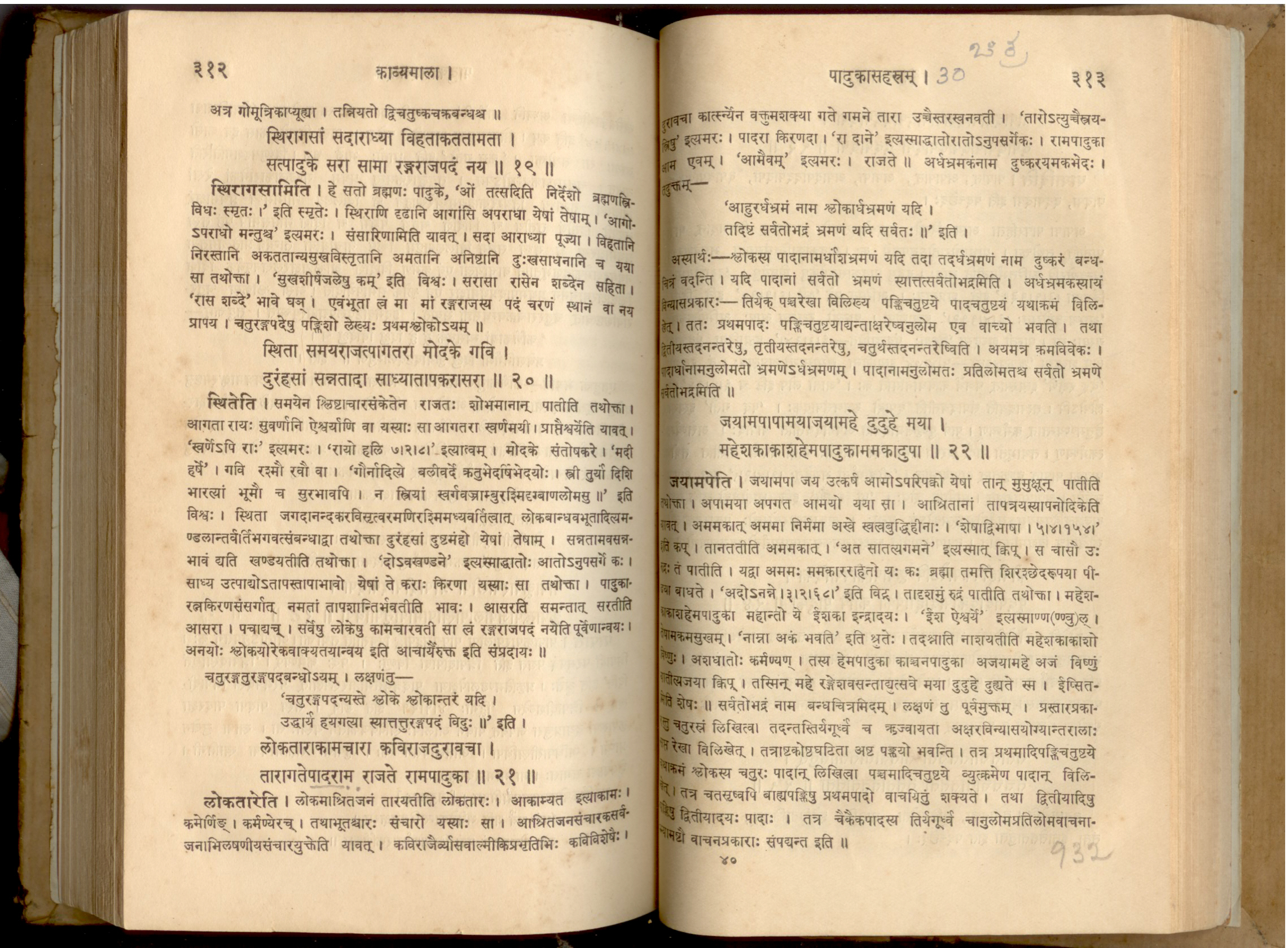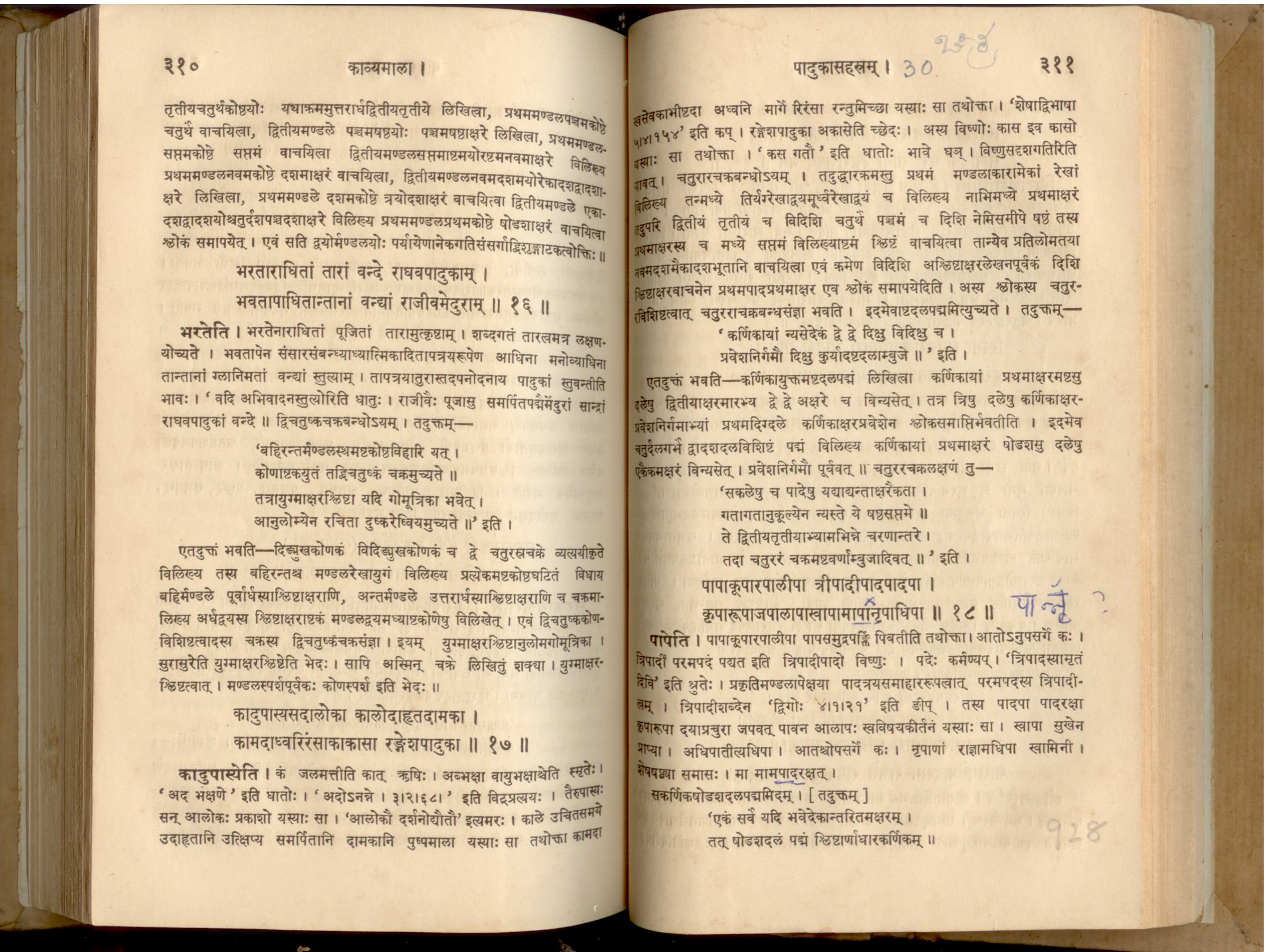|
Knight's tour in the Padukaa
Sahasra, Haravijaya, and other Sanskrit Literature |
|||
|
This page is devoted to many contributions to Combinatorics from Indian Classics (currently containing classics in Sanskrit). It shows various solutions to the Knights tour problem - that of making a Chess Knight visit all squares of an chessboard exactly once. This problem has fascinated many for centuries, including the great mathematican Euler. The solutions on this page are for a 4x8 board, but can be seamlessly repeated to get a complete solution for the whole board. They include both a prayer form in the "Padukaa Sahasra" about 1300 A.D., as well as the earlier forms in the HaraVijaya of Ratnakara (about 800 A.D.), and the Kavyalankaraa by Rudrata (about 900 A.D.). The links on the page are to various Sanskrit classics, which have information regarding both Knight's tours, as well as other amazing combinatorial jugglery with Sanskrit poems. The pictures below show the Knights tour in the Padukaa Sahasra, a piece
with 1008 verses devoted to Lord SitaRama's sandals (worshipped by
Bharata during Lord SitaRama's stay away from Ayodhya), written by
Sri Vedanta Desikar around 1300 AD. These tours
are presented in Chitra-Kavya form (picture-poem in Sanskrit). This
poetic form begins with one verse, and derives another meaningful one, by systematic
permutations (e.g. according to a Knight's tour of a board) of the
same - an amazing feat! Several more Chitra-Kavya's are
shown in the same Padukaa Sahasra page - e.g. "LokaTaraaKamaChara
...", is written half on a chessboard, reflected through the center,
and the result can be read sequentially either horizontally or
vertically in a meaningful sense on the board.
Chess knight circuit (G. S. S. Murthy's Translation) Sthiraagasaam sadaaraadhyaa vihataakatataamataa| Satpaaduke saraasaa maa rangaraajapadam naya|| Sthitaa samayaraajatpaagataraa modake gavi| Duramhasaam sannataadaa saadhyaataapakaraasaraa|| The author beseeches the sandals of God to help him reach the abode or the feet of God. The two slokas together form one sentence. Sat+paaduke = O Sandals of Brahma, Sthira+aagasaam, Sadaa+aaraadhyaa = (you are )always revered by the worldly who are confirmed sinners, Vihata+aka+tata+amataa = (you are) the destroyer of unhappiness and instruments of unhappiness, Saraasaa = (you are) always accompanied by (the jingling) sound (of trinket bells attached to the sandals?) Maa, naya = take me, Rangaraaja +padam = to the feet or abode of God. Samaya+ raajat+paa = (you are ) the protector of those shining through their good conduct, Aagata+raa = (you have) attained brilliance of gold, Modake = (you) dispense joy, Gavi, sthitaa = (you) are at the center of sun, Durahmasaam, sannataa+daa = (you are) destroyer of the despondency of the wicked, Saadhya+ataapa+karaa = rays (of your gems) have the power of removing the heat (of the devotee),
Aasaraa = (you) move all around,
One knight jumps like three rook-wise steps. Past sore too mean; so just for free, Hopes here, turns there, flies each goose now. Can't place last word? Won't find the sea
One, two, three, four! See each word here: Jumps so wise now find their place passed. Terns can't soar like flies the free rook; Goose steps just won't mean knight hops last.
- D. E. Knuth, Jan 6, 2005
Excerpts on the various forms of Chitra-Kavya's and
related poetics from Kunhan Raja's "Survey of Sanskrit Literature"
Bharatiya Vidya Bhavan, 1962 are also included.
|
|||


|
|||
| Address: IIIT-Bangalore, 26/c, opp Infosys
(Gate 1), Electronics City, Hosur Rd, Bangalore-560 100
Tel: +91 80 28527627-635 version 5.0 on December 15, 2004 Best viewed with Internet Explorer 6 and Mozilla Firefox |
|||
 shows the Knight's tour in the top left corner. The first
sloka is written sequentially, and the second one is read off it,
following the tour - which is also marked in Devanagari
numerals.
shows the Knight's tour in the top left corner. The first
sloka is written sequentially, and the second one is read off it,
following the tour - which is also marked in Devanagari
numerals. shows the two slokas - the first on the top left of the
left page, and the second following it
shows the two slokas - the first on the top left of the
left page, and the second following it lists the preceding Sanskrit material for reference
only.
lists the preceding Sanskrit material for reference
only. is the cover page of the 1911 book from which we have
taken this material. The translation of these slokas (following the commentator Sriniwasa) is given below:
is the cover page of the 1911 book from which we have
taken this material. The translation of these slokas (following the commentator Sriniwasa) is given below: